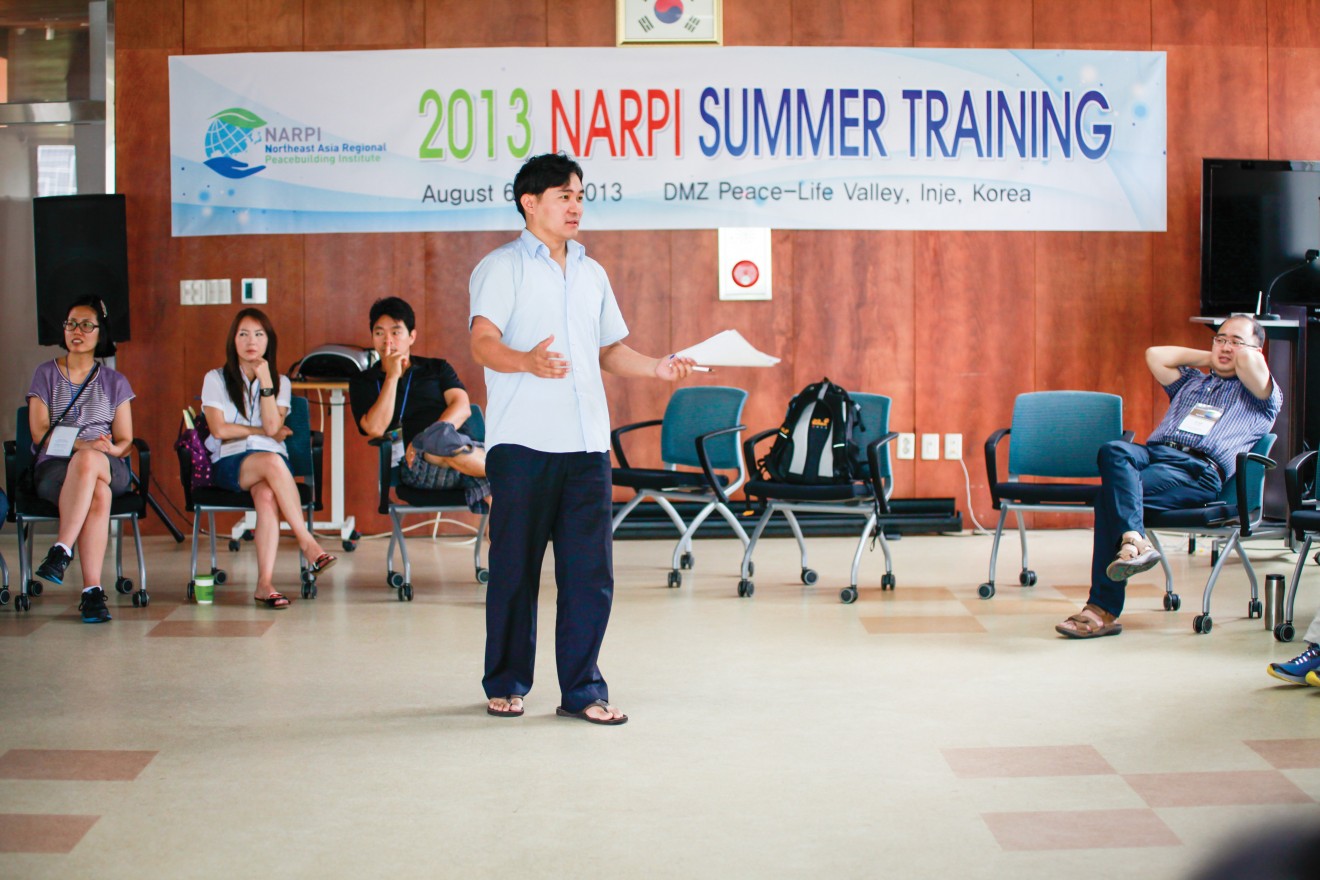
In mid-October 2014, winter’s chill had arrived in South Korea. Inside a spacious conference room on the main floor of a newish multi-story building, 14 teachers were chatting animatedly about ways to be restorative in their lives and classrooms.
They were participants in an advanced workshop on restorative justice sponsored by the Korea Peacebuilding Institute (KOPI). The glass-walled room was in the heart of Bundang-gu, a section of the Seoul capital region known for its luxury high-rise condominiums and high-tech companies.
That evening, in an equally spacious room on the second floor of a neighboring building, about 50 people gathered to inaugurate the southern branch of KOPI with speeches, refreshments and socializing.
This KOPI branch is anchored in upscale Bundang-gu to make it accessible to Seoul-area teachers, counselors and administrators who recently became interested in non-violent ways to forge harmony in their schools.
“Two years ago, nobody had heard the term ‘restorative discipline,’” workshop leader Jungki Seo tells a Peacebuilder reporter. “Here especially in Gyeonggi province [which surrounds the city of Seoul and adjacent Bundang-gu], the schools have adopted restorative discipline as the main way of addressing conflict.”
This interest developed after capital-area school leaders decided that hitting students would no longer be permitted. Questions arose. Could teachers control recalcitrant or even violent students, without military-style punishments, exercises in humiliation, or expulsion?
At about the same time, stories were circulating in South Korea’s media about the high rate of suicide among the country’s teens, often attributed to bullying, but also to the extreme pressure to excel on academic tests.
Newly formed KOPI stepped forward with this answer: To intensively train interested school personnel (who would then train others) in the principles and practices articulated in the Korean translation of The Little Book of Restorative Discipline for Schools: Teaching Responsibility; Creating Caring Climates by Lorraine Stutzman Amstutz and Judy H. Mullet, plus several other titles in the Little Book series.[1]
“Our minimum goal is to create safe spaces where people can gather to deal with sensitive issues,” says KOPI director Jae Young Lee, MA ’03. “Korean society has nurtured a violent culture in schools. Power is top down. Students are expected to focus on their grades to the exclusion of healthy relationships.”
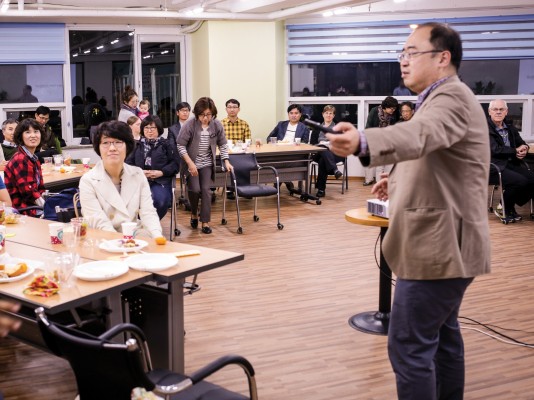
Jungki Seo is the head of this new branch of KOPI, which is 15 miles from the main KOPI office in Deokso. Seo stepped away from university teaching to commit himself fully to co-founding KOPI in 2012 and being a key trainer for the school initiative. In addition to holding a PhD in anthropology, Seo completed three courses at EMU’s 2008 Summer Peacebuilding Institute, including restorative justice with Howard Zehr and trauma healing with Nancy Good (Sider). In mid-2014 he returned to EMU and became certified as a trainer of STAR (Strategies for Trauma Awareness and Resilience).
To complete the entire series of trainings, school personnel must commit themselves to 128 hours of KOPI coursework over about a year, divided into introductory, intermediate and advanced levels. The introductory level costs the equivalent of about $200 (U.S.) for 24 hours. Completion of the whole series adds up to $1,450. In 2014, 200 people started at the introductory level and 30 went all the way through the advanced level.
The schools have paid for some of these trainings, but many participants have dug into their own pockets for it. And yet there are more who want this training throughout Gyeonggi province than KOPI can handle.
Adapting to changing circumstances
The small group of low-paid visionaries steering the KOPI boat have learned over time to tack with the prevailing winds, always heading in the direction they desire in terms of building peace on the Korean peninsula (indeed in the whole Northeast Asia region), but understanding that their journey may look like zig-zagging, even backtracking at times.
KOPI has grown from four staff members to 18 since it was founded in 2012. Most of these staffers work from two rooms, plus a small adjoining kitchen, in Deokso – a moderately priced, edging-into-farmland suburban city just east of Seoul.
KOPI is focused heavily these days on spreading restorative practices through area schools and, via young people and their mentors, into the wider community.
In addition to leading KOPI, Lee coordinates the Northeast Asia Regional Peacebuilding Institute (NARPI), founded in 2008. NARPI rotates three intensive weeks of summertime training among locations in countries that don’t always get along on the official level – so far NARPI has been held in South Korea (twice), Japan and China. Mongolia is the site of the 2015 summer session, hosted by a local organizing committee.[2]
The roots of both KOPI and NARPI (both explicitly secular organizations) can be traced to an organization of Mennonite-style Christians – the Korea Anabaptist Center founded by Lee, Kyong Jung Kim and Tim Froese, in 2001.[3]
Wanting to promote a cultural shift toward peace in the region but short of funds, the Korea Anabaptist Center decided to raise money by launching a for-profit, English-language training institute in 2004.
Staffed largely by fresh graduates from Mennonite colleges in North America, Connexus did well until the end of 2011 by catering to financially secure professionals in Seoul.
Buoyed by the proceeds of Connexus, Lee was able to experiment, trying a variety of ways to introduce peacebuilding concepts into the military-oriented, hierarchical culture of South Korea. For about six years, he tried offering his services and giving talks at no or low cost to churches, schools and judicial officials.
“Sometimes six or seven people would show up, sometimes 20 people would show up,” he says. “I didn’t have high expectations, so I wasn’t disappointed if only six or seven came.”
For two or three years Lee taught teachers mediation skills to use within their schools. But the teachers had no official backing – no official time off to pursue mediation and little top-level support for applying it. So they drifted away.
In 2006, Lee got a breakthrough. The government agency responsible for Seoul’s courts and family issues asked Lee, in cooperation with the Women Making Peace group, to run a pilot project of using a restorative approach for handling juvenile offenders. “Everybody got excited,” Lee says. “Over two or three years, we developed 20 or so trained volunteer mediators.”
In 2010, most of the mediators Lee trained were hired as official court-system mediators, soon joined by others not trained by Lee. “The number of mediators grew so fast, they hired anybody whatsoever,” he says. “The courts were looking for quick fixes, rather than investing in addressing the root causes of offenses.”
Another problem: the head judge changed on an annual basis (South Korea’s way of combating judicial corruption). But the unfortunate result, says Lee, is that he would spend a year educating a head judge about restorative justice, only to see that judge leave and be replaced by a less understanding judge, requiring Lee to spend the next year repeating the process.
“There was no long-term stability, no deep change in the judicial system,” Lee says. “So we decided to try another path – to focus on working at change at the community level through local schools, local teachers, local young people, and local families.”
At about the time Lee’s court-system work was coming to an end, members of Seoul’s business community stopped enrolling in English-language classes at Connexus, a shift attributed to the worldwide recession. Income could no longer cover expenses, especially in the high-rent district where Connexus held its classes.
Crisis and recovery
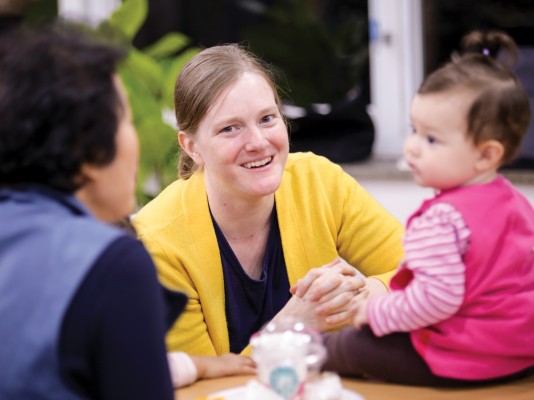
Crisis time. Hours of prayer, conversation, and soul-searching led the Korea Anabaptist Center to a momentous decision to separate itself from Connexus in 2011. Mennonites in the United States lent the Korean Anabaptists $10,000 interest-free to wrap up their Connexus operations downtown (money since repaid).[4] The Anabaptist Center shifted to Chuncheon City, two hours northeast of Seoul, the home of the first Anabaptist Church in Korea, Jesus Village Church.
Jae Young Lee, Karen Spicher ’02, and the other Anabaptists who chose to remain in the area of Seoul reassembled themselves under the secular mantle of a new organization, Korea Peacebuilding Institute.[5] They put the main office of KOPI – joined by NARPI – in much cheaper rental space in Deokso, about 15 miles east of downtown Seoul.[6] Government entities, like schools and courts, feel more comfortable doing business with secular organizations like KOPI than with overtly religious organizations, explains Lee.
Connexus was reconfigured as an after-school language program in the suburbs for families who wanted their children to learn English from native speakers in a non-competitive atmosphere (making it unlike the highly competitive, rote-learning, test-driven approach of many other private after-school programs). In its first two years, the reconfigured Connexus school [www.connexus.co.kr/english] grew from 10 students to 105, from two teachers to six.
The Deosko group of Anabaptists didn’t ditch their religion. They worship on Sunday mornings in an egalitarian fashion, with a warmly relaxed gathering around a table organized by a rotation of lay people, followed by a shared lunch.
On the morning of October 19, for example, 17 adults and five children at the worship session explored this theme through Scripture readings, hymn singings, prayers and conversation: “Your work produced by faith, your labor prompted by love, your endurance inspired by your home in Jesus.”
Someone made reference to the number of conscientious objectors (600 was the figure) serving jail terms in South Korea due to their refusal to serve in the military, including a member of this Anabaptist church group. “We’re not free from violent structures,” murmured one attendee.
Communal-flavored way of life
As of late 2014, Lee, Spicher and their daughters Lomie and Aurie, were living in a relatively new cluster of low-rise buildings near Deokso. Their three-bedroom apartment is also home to Sarah Wilson, an English teacher who had arrived in South Korea several years ago as a MCC volunteer with SALT (Serving and Learning Together). They frequently host visitors.
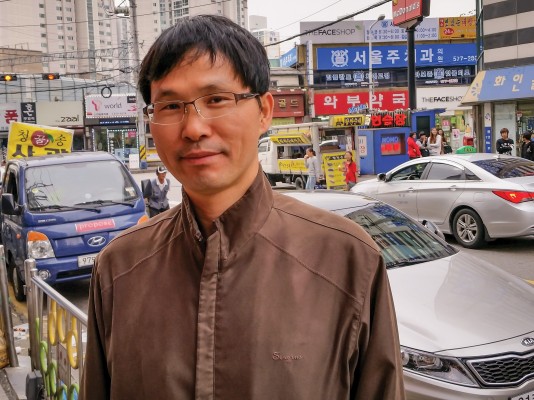
Spill-over guests are dispatched across the hall to a bedroom in the apartment where Lee’s elderly parents live. In apartments above and below them, as well as in a neighboring building, live many others connected to KOPI, NARPI or Connexus. Typically, five staffers share one apartment.
Connexus teachers are mostly fresh grads from Goshen, EMU, Canadian Mennonite University and other such Anabaptist institutions in North America, who sign up for at least a year of teaching in return for lodging, a food allowance and monthly salary of $1,000.
On most mornings, almost everyone in these residences heads to work in the same commercial building, characterized by small ground-level stores lining a busy street. Occupying much of the fifth floor, the classrooms and offices of Connexus are about 30 feet away from KOPI’s and NARPI’s shared work spaces. At noon everyone in these rooms emerges to enjoy lunch together in a conference room, with staff rotating food preparation in the galley-sized kitchen.
The communal-flavored way of living; the latest iteration of income-generating Connexus; the decision to move most of the peacebuilding team from an expensive Seoul neighborhood to comparatively working-class Deokso … These all evolved in 2011, the same year that NARPI held its first three-week summer session in Seoul, with 47 participants, plus 28 staff, from 11 countries.[7]
“The past year has not been easy,” Spicher said in a Mennonite Mission Network newsletter published soon after the 2011-12 transitions. She added, however, that it had been “a faith-affirming experience to witness God’s provision of everything we need and more.”
Spicher told Peacebuilder that her husband has “no fear of the unknown.” In fact, “moving and changing are energizing to him.”
Lee doesn’t come across as a pushy person. He just has lots of ideas, a way of articulating them well, and boundless energy. Everyone says Connexus and peacebuilding institute decisions are made collectively and generally by consensus. Spicher described Lee’s leadership style as “visioning together.”
The latest vision is to move the entire Deokso operation – KOPI, NARPI and Connexus – into space formerly occupied by a restaurant on a nearby busy thoroughfare. “Jae thinks having a coffee shop would provide us with more financial stability,” Spicher said.
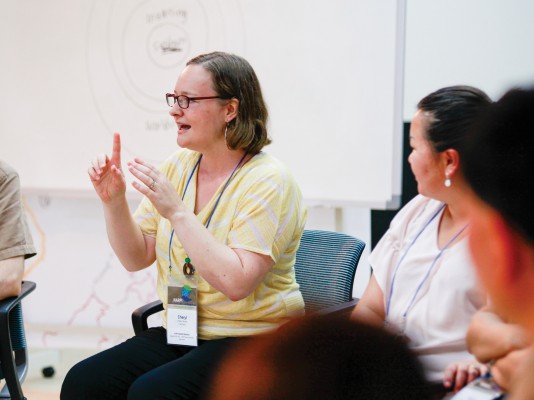
Yet, “he’s not a micro-manager,” she emphasized. “He needs detail people around him. His role is to shift to where he is most needed. If others are doing fine with their work, he’s fine in giving them the space to do it their way.”
Spicher, with her native command of English, does the communications for NARPI, which uses English as the language that permits most attendees from the Northeast Asia region to understand each other. A volunteer staff keeps the books balanced. Well-trained facilitators run most of the workshops, some brought in from other parts of the world, sometimes including people connected to EMU’s Center for Justice and Peacebuilding, such as Howard Zehr, Carl Stauffer and Al Fuertes.
‘Everything starts from one person’
Of the 17 adults who attended the October 19 worship service in the NARPI/KOPI conference room in Deokso, seven had been through at least one of NARPI’s intensive summer sessions.
Manshik Shin, for example, has participated in NARPI for three of the four years it has been held. After attending the first NARPI gathering in Seoul in 2011, Shin traveled to Hiroshima, Japan, for NARPI 2012, and to Nanjing, China, for NARPI 2014.
For Shin, this was a major investment, both in money and time. He’s a 44-year-old high school history teacher, with a wife and three children, 9, 11 and 14. The family must travel over an hour to attend Sunday morning worship sessions in Deokso.
Shin says he got interested in NARPI when he took a restorative justice course in 2011 co-taught by Jae Young Lee and Jungki Seo. “Sometimes there is conflict between students, sometimes between students and teachers, sometimes between teachers and parents. I learned how to deal with this conflict.
“I learned that the punishments the school was giving students – like making them clean the playground or classroom – were not changing their behavior. And we kept offenders and victims separated and didn’t spend much energy to help the victims. After I understood restorative justice, I felt I could understand what’s wrong among our Korean society.”
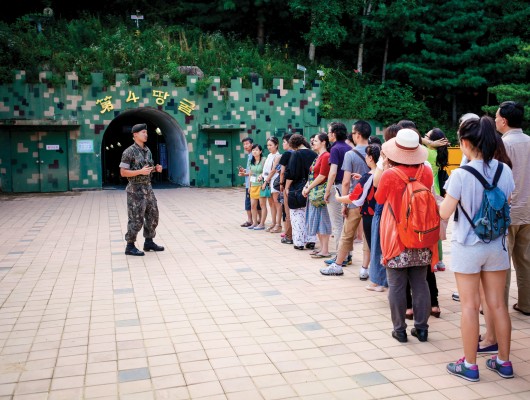
Shin paused and pointed at a book lying on a conference table. It was the Korean version of Changing Lenses by Howard Zehr. “After I read it, I could understand what to do – it got my imagination. It gave me insights.”
Each NARPI session includes field trips and talks that allow participants to gingerly explore (and seek to begin healing) historical traumas that one participating nationality may have inflicted on another. Shin was moved by the stories told by Chinese survivors of the WWII-era massacres by Japanese troops in Nanjing. And by hearing from the survivors of the atom bomb dropped by the United States on Hiroshima. And from Korean “comfort women,” used sexually by Japanese soldiers.
It is rare, explains Shin, for people from different countries to meet and intentionally and caringly talk about the harms inflicted on others in the name of one’s own patriotism. The ultimate lessons, though, were ones of hope. Even the victims asked that they serve as inspiration for “never again,” for peace. They held no rancor.
Shin now believes that “everything starts from one person,” and he’s that person in his 700-student school. He has introduced restorative circles in that school and he’s training facilitators for those circles.
He is interested in egalitarian churches now. “In Korean churches, the pastor is the focus. He gives long sermons and everyone sits and listens to him.”
Shin motioned to his present surroundings, where he had joined 16 others in worship an hour previously. There was a simple multi-purpose room with a homemade wooden baby’s crib by the conference table and, on the wall, a Martyrs Mirror sketch of Mennonite Dirk Willems rescuing the man who had been hunting him, labeled with the words “Love your enemies and bless them that curse you.” And Shin commented, “Frankly speaking, I like these people, these Mennonites. They are culturally different in a way that I like.”
Footnotes
- Jae Young Lee co-translated into Korean the Little Book of Restorative Discipline. Other Korean Anabaptists translated these Little Book titles: … of Restorative Justice by Howard Zehr, … of Trauma Healing by Carolyn Yoder, … of Conflict Transformation by John Paul Lederach. … of Strategic Peacebuilding by Lisa Schirch, … of Circle Processes by Kay Pranis. In addition, Lee edited the translation of Changing Lenses – A New Focus for Crime and Justice by Howard Zehr.
- NARPI’s 11-person steering committee currently consists of five people from Japan, two from China, two from South Korea, one from Mongolia, and one from Taiwan. Each year the NARPI Summer Peacebuilding Training is hosted by volunteers native to the location where the session is held. But NARPI’s main organizing team – behind the website, main telephone line, communications, and accounting – is housed within the office shared with KOPI.
- See the following article on Jae Young Lee’s journey to peacebuilding via Mennonite universities in North America. “Anabaptist“ is often used as an umbrella term for Mennonites and kindred pacifist-Christian sects.
- Mennonite Central Committee, Mennonite Mission Network in the U.S., and Mennonite Church Canada Witness have at different points between 2001 and 2015 all stepped forward with support for projects envisioned by Korea’s Anabaptists.
- Jae Young Lee gained a full-time partner in 2010 when he married Karen Spicher, a fellow EMU alumnus who arrived in South Korea as a Connexus teacher in 2007.
- Three years later, in October 2014, KOPI opened a branch office back in an upscale business district, in response to the growing demand for teacher training in restorative discipline, as discussed earlier in this article.
- In the summer of 2014, NARPI was held in Nanjing, China, organized by Liu Cheng, a Nanjing University history professor, assisted by students. Seventy-three people from nine countries were in attendance, either as participants, facilitators or staff.